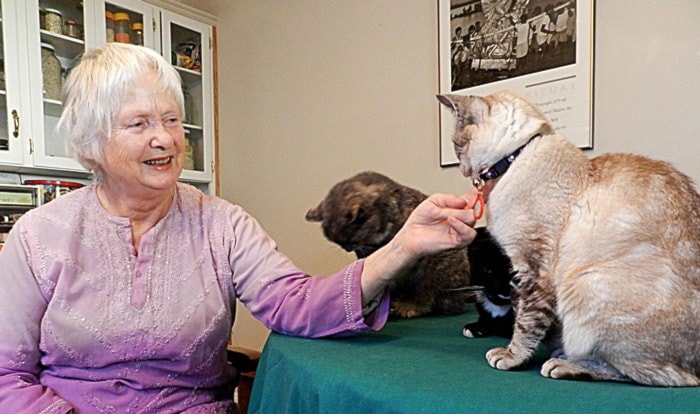A local resident is seeking council’s approval to continue operating a temporary animal hospice in downtown Hope.
For 25 years, Om Sairam has been providing care for aging and ailing cats that are deemed unadoptable. She currently spends about $600 a month on food and cat litter for 17 cats living in her home on Hemlock Street. She also cares for three dogs dogs that were abandoned.
“I have chosen to help animals that are the throwaways of society and that cannot help themselves,” said Sairam, who has volunteered at local veterinary offices and received training from the Vancouver Humane Society.
“Aged animals do not do well in shelters because volunteers are far and few between. They have special needs and would not get the care they require and simply perish in shelters.”
Several bylaw issues have been raised by the district after a neighbour complained that Sairam’s cats were running at large, destroying landscaping, defecating and spraying on neighbouring properties.
Her property is currently zoned as single family residential, which does not permit use of an animal hospice. The district requires Sairam to apply for a variance to bylaw requirements and take the necessary steps to reduce the number of animals on her property. The dog responsibility bylaw limits the number of pets per property to five, consisting of no more than three dogs or three cats.
Council has approved several conditions Sairam must meet before they will consider granting her permission to continue operating the care facility. However, no time frame has been set for compliance.
The five conditions are: obtain support from the majority of neighbours within a 150 metre radius; submit an inspection report on the physical health, behaviour and environment assessment of all cats on the property; cease to intake further cats and reduce the number through natural selection to the allowable bylaw limit; submit a shelter continuity or emergency plan should operational issues and management of the cats become a challenge; and agree to keep all cats securely confined either indoors or in an enclosed back yard.
Sairam says she’s already received 15 letters of support from neighbours and has always had an eight foot fence in her backyard preventing the animals from escaping. She feels the district is trying to penalize her for providing care to animals that would otherwise be euthanized. Sairam has agreed to not take in anymore cats, but wants council’s permission to allow the ones she has to live out their remaining life on her property. The majority of her cats are over the age of 14.
“I really think I’m being victimized,” said the 75-year-old woman.
“I’m doing something that the city is refusing to do. They stay on the property and they don’t go anywhere. The cats are maintained. They are not running free.”
Coun. Peter Robb has suggested the district work with other community groups and Sairam to bring a solution back to council. This could include making changes to the existing bylaw.
“The feral cat problem has been huge for a long time and hasn’t been addressed. Everyone’s kind of ignoring it,” said Robb.
“She’s doing the community a service by looking after the aging cats. I hope we can help her in some way. There is a consensus that we want to make something work, but we don’t know what it is yet.”
